Comparative review of 2-SIM Androidophones - Highscreen Cosmo Duo and Gigabyte Gsmart G1310
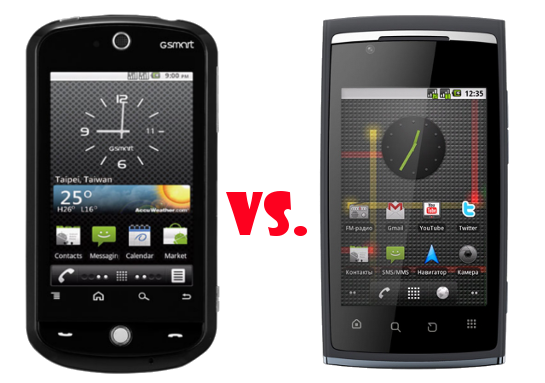
Disclaimer : I think that this article will be of interest to Habr’s audience, and in particular, Android lovers, since I haven’t seen such a comparison on the net. Just the mention of Gigabyte in passing in the Cosmo Duo review on Mobile Review. Well, I haven’t met - you have to do it yourself. In addition, there are still few such devices on the Android smartphone market, so we are considering what is. The text is designed more likely for those who need to use two SIM cards in the first place for work or other reasons. For the rest - it's just my personal assessment of two similar Android-based devices. I do not set myself the task of comparing with top-end devices on the same platform, these are devices of a different class and for different tasks.
Upd: thanks hhrhhrfor links to comparisons of devices on the network, there is something to compare .
If all of the above is interesting - welcome to cat.
So, I managed to test two dual SIM cards on Android - Highscreen Cosmo Duo and Gigabyte GSmart G1310 . Immediately make a reservation, JiSmart came across to me in the form of an engineering sample, but I do not think that it is fundamentally different from the serial versions.
Both phones were tested in MegaFon-Moscow and Beeline networks (which SIM cards were available).
First, a few words about design.
The appearance of both devices is very concise, both manufacturing companies have clearly worked on it and worked well. In Gigabyte, the branded round speaker grid and the round button under the screen in the middle immediately catches your eye. In Cosmo Duo, there are beveled ends at the back of the device, which gives it the appearance of a sort of arch and makes it easier to hold in your hand.
On the showcase, both devices look quite solid, without brightly expressed youth elements, these are more likely phones for business people who need to be in touch no matter what. The devices are identical in size, Cosmo Duo looks a little thinner thanks to the bevels on the back, which were mentioned above.
We take both phones in our hands and ... Here interesting tactile transformations begin. If Gigabyte looks like a neat business apparatus, not an image one, but a kind of “workhorse”, then when used this feeling is dispelled. The materials used in the device are cheap, the thin cover of the battery compartment creaks, you take the device in your hand - all the charm instantly disappears. And these round things that could be forgiven by making a discount on the corporate appearance begin to annoy. And the clause about the engineering model does not work here, the materials and assembly do not stand up to criticism. The gap between the bottom edge of the screen and the physical (oh my god, at least something) buttons is terrible, it looks clumsy. By the way, I don’t know exactly how many people tested the device before me,
There is a Ukrainian proverb, in a free translation, it sounds something like: “You take it in your hand - you feel a thing.” This proverb applies to the Gigabyte device to the exact opposite. Outwardly quite concise and neat (with reservations), when used, it disappoints. If I had chosen a dual SIM Android smartphone, I would take a Gigabyte in the store in my hand and immediately return it to the seller, not even including it.
As for Cosmo Duo, the situation is different. The phone and on the window looks impressive, whole, in the hand lies comfortably, without causing discomfort. Yes, there are no physical keys for sending a call and hanging up, but in the light of a comparison with Gigabyte this is more of a plus. The rest - well cut, tightly sewn, especially nothing to talk about. In the dual-SIM model, diode indicators on the end were abandoned, unlike the single-SIM Cosmo. Well, right, the positioning and audience of the devices are different.
Speaking of buttons. A few words about the rest of the controls.
Gigabyte and here it seemed to me uncomfortable. I have met such an arrangement of the power buttons and the camera, for example, on the Acer Liquid, but in this case it is implemented extremely poorly. The power button is located on the left on the upper end, the headphone jack is also on the right, the camera button is on the right end at the bottom. When unlocking, the camera key is constantly pressed and you have to first exit the application, and only then work with the phone. In Liquid, the power key is located on the left side, so the location of the camera button does not cause inconvenience. It on Gigabyte should either be drowned harder, or moved.
In Cosmo Duo, the camera key is also located, but it only protrudes slightly and no accidental clicks occur. The power button and headphone jack are located on the contrary, which is more convenient for a right-hander.
In general, in general, the management in Cosmo Duo is more thoughtful and convenient. Ergonomic, as they say.
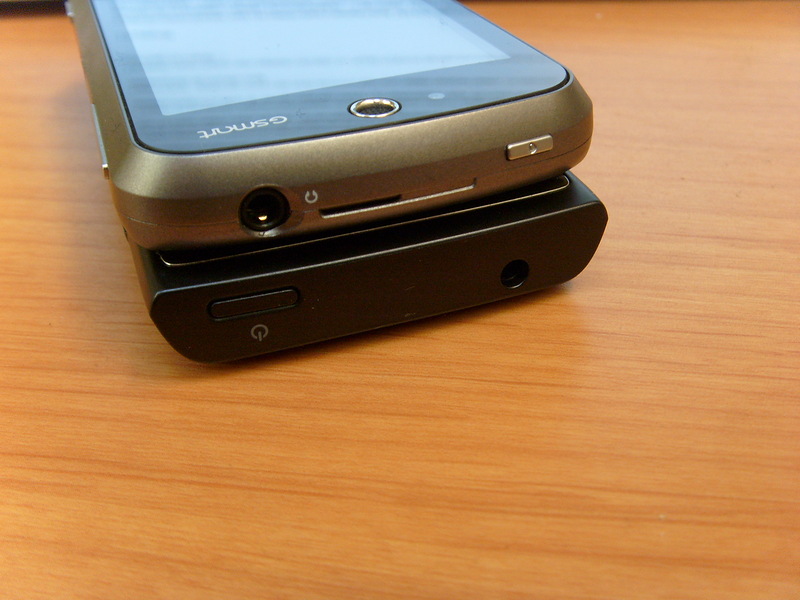
And the last stone in the Gigabyte garden by design is the key under the screen. The same, round, corporate key. On the Gigabyte GSmart G1305 , which I also reviewed, a trackball was located in this place, which at least made sense, sometimes speeding up the work in the phone menu. In G1310, it’s just a physical key that performs an Android function ... yes, yes, just a “menu” function, for which there is already a touch key above the physical block. The only justification for the existence of this element is that it visually separates the call and end keys. Could come up with a more interesting practical application.
We go further, talk about the internal structure of both models.
Do you think I will again scold Gigabytes? I will, but less. Here he has several advantages over the competitor and about them below.
The location of two SIM cards. In the G1310, SIM cards are inserted one above the other, the slot is slightly to the right of the camera, to replace the SIM, you need to remove the battery. Frankly, removing and inserting SIM cards is inconvenient, difficult. Especially the first (lower) one, as no guide is provided on the board itself, there, as can be seen in the photo, is just a wiring of the slot.
The slot for a memory card on the end and it can be installed only by removing the cover, the battery is not required to be removed.
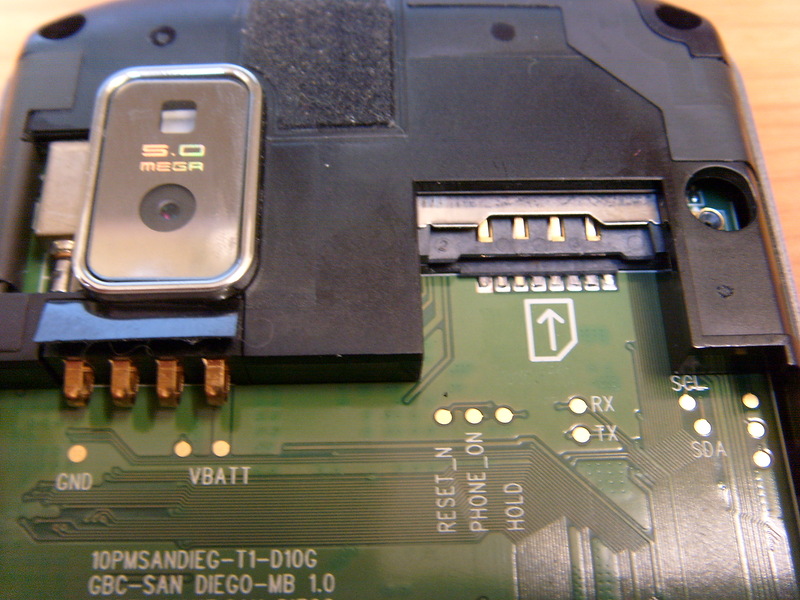
Now Cosmo Duo. Here I will scold Highscreen engineers. Yes, the slots for SIM cards are separated, it’s more convenient to manage SIM cards than in Gigabyte, but why couldn’t you make a slot for a memory card outside, like in Gigabyte? I can’t say, but the solution is not the most convenient, you can give up on the hot-swap KP - you won’t get to it without removing the battery.

If in Gigabyte it does not matter which slot the SIM card is installed in - they are controlled from the menu, then in Cosmo the slots are signed - where is WSDMA / GSM, and where is only GSM.
Is it good or bad? I tend to be good. My “distribution of roles” was like this - MegaFon for data, Beeline for voice / SMS. Therefore, in Cosmo Duo, I knew for sure that when you turn on the phone will not get into the network via a Beeline SIM card. In Gigabyte, this is configured already after switching on - Sim1 (2G) & Sim2 (2G), Sim1 (3G) & Sim2 (2G) and Sim1 (2G) & Sim2 (3G) modes.
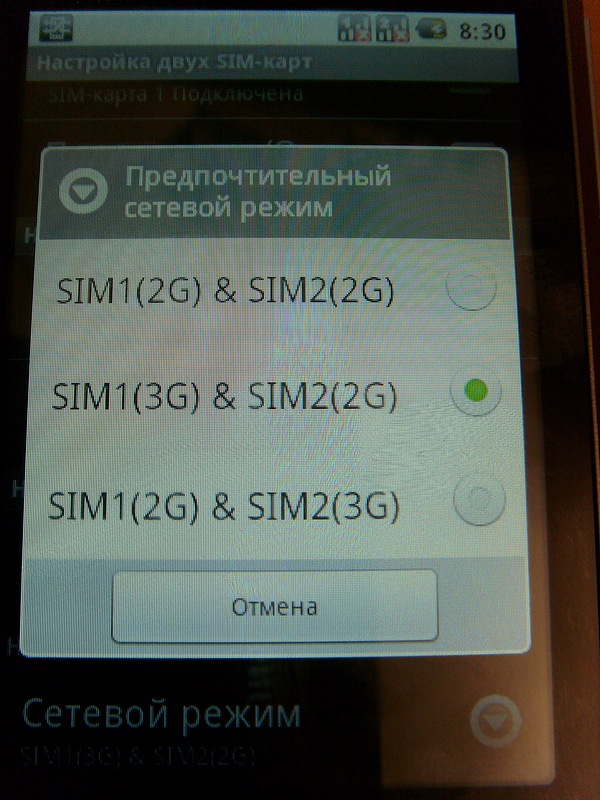
In Gigabyte, in the settings, there is a separate item called Dual Sim, where the behavior of SIM cards and their roles is regulated, in Cosmo Duo, there is a separate section for each sim. In my opinion, the implementation in the G1310 is more flexible than in the Cosmo Duo, but this is dictated by the physical arrangement of the slots rather than the real need.
One way or another, both approaches have the right to life, which is more convenient - you choose.

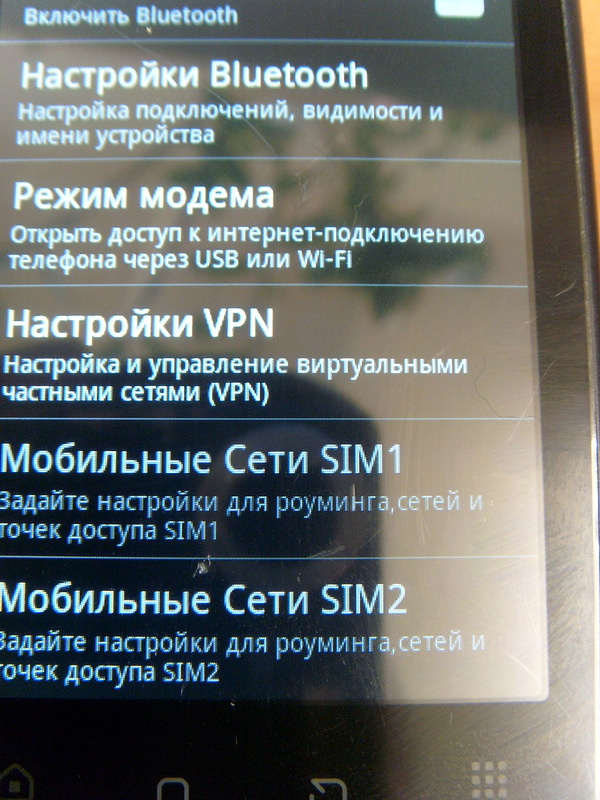
An interesting point - if in Gigabyte the indication of SIM cards on the screen is located left to right, then in Cosmo Duo it is the other way around. Those. first network 2, and then network 1. What made Highscreen developers implement it like this is a great mystery. It does not interfere, you get used to it over time, but at first it constantly catches your eye.
Now about the filling.
The Highscreen Cosmo Duo has a Qualcomm® MSM7227-1 ™ processor, 600 MHz, while the Gigabyte Gsmart G1310 has Qualcomm® MSM7225-1, 528 MHz.
The amount of memory in both devices is the same, RAM 256 mb, ROM 512 mb.
Cosmo Duo has a more capacious battery, 1500 mAh versus 1260 mAh in Gigabytes.
The camera module installed in Cosmo has a resolution of 3MP, in Gigabyte - 5MP, which, however, has almost no effect on the quality of the photo. A Gigabyte can be added to the advantages of a flash that can be used as a flashlight (you need to install the program yourself), in Cosmo Duo the camera is not equipped with a flash. However, if my assumption is true and the devices are aimed more at a business audience, then the Highscreen approach is more justified, it is not rare and has a lot of examples in the past. For example, Nokia E61 did not have a camera module at all, although the device clearly tried to compete with the “blackberry” in the business segment of the market. In any case, the camera is not the most necessary element in the phone of a business person. Take a photo on a contact or record something so as not to forget, that's enough,
And the last point is In Use.
Below is exclusively my experience of using devices, practically unreasonable and extremely subjective.
Regarding the reception quality - oddly enough, the G1310 wins here. Under equal conditions, he caught the net more confidently than Cosmo Duo, although both provided a level sufficient for conversation.
In general, as one could understand from the material, I liked Cosmo Duo more than a Gigabyte, primarily because of its apparent reliability. This is not about actual reliability, no one would give me a car to drive on the phones, but rather about its tactile reliability, at the level of sensations. Gigabyte, however, caused a feeling of fragility, probably due to poor build quality and materials. Not the last role was played by the filling. Cosmo Duo for a couple of weeks of use crashed and rebooted only once or twice, while Gigabyte did it a couple of times a day stably.
Yes, and small roughnesses in the software outweighed the scales for me towards Cosmo. When you press the physical “call” button in G1310, your own call shell appeared explicitly, when you press the on-screen button, it is standard, but with the changes made. Namely, an alphabetical index appeared to the left of the call list. It seems to be a useful thing, like speed dialing, but it occupied exactly half of the screen space on the left, and the “call” button in the call list is on the right of each contact and to get to it you need to make a “slide”, thereby hiding “speed dial” . This is terribly annoying when you need to urgently call back, and you stumble on an interface that is not thought out to the end. As you know, such an implementation made the set not fast, but quite the opposite.
In Cosmo, they did not become wise and left the standard Froyo interface, familiar to other devices on this platform, realizing only the work of two SIM cards.
Both devices have the ability to dial from any of the two SIM cards, more or less the same, there are no complaints about any of them.
Total:
Gigabyte GSmart G1310 - weaker filling, weak battery, poor design. From 6 347 to 6 990 rub. according to Yandex.Market.
Highscreen Cosmo Duo is a slightly more powerful filling, a more powerful battery, and high-quality body materials. From 6 347 to 7 190 rubles. according to Yandex.Market.
My personal sympathies are on the side of Cosmo Duo, about yours - you decide. Have a good choice. ;-)
PS It is interesting to observe the post and karma - the post is in the black, karma is on the wane, not a single comment. If only they would write who is not satisfied with anything. To whom it is not clear - I will explain, add etc.
